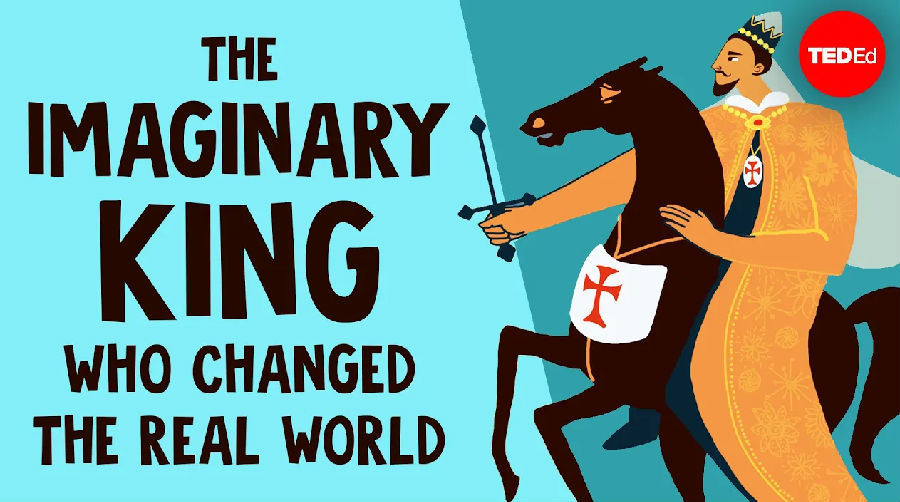In 1165, copies of a strange letter began to circulate throughout Western Europe.
在1165年,一封奇怪信件的副本开始在整个西欧散播。
It spoke of a fantastical realm, containing the Tower of Babel and the Fountain of Youth -- all ruled over by the letter's mysterious author: Prester John.
它谈及了一个梦幻般的国度,其中包含通天塔和青春之泉,所有这些都在这封信的神秘作者,祭司王约翰的统治之下。
Today, we know that this extraordinary king never existed.
今天,我们知道,这位非凡的国王从未存在。
But the legend of this mythical kingdom and its powerful ruler would impact the decisions of European leaders for the next 400 years.
但是,这个神话般王国的传说及其强大的统治者将在未来400年影响欧洲领导人的决定。
Prester John's myth would propel the age of exploration, inspire intercontinental diplomacy, and indirectly begin a civil war.
祭司王约翰的神话将推动探索时代的到来,激发洲际外交,并间接引发内战。
When Prester John's letter appeared, Europe was embroiled in the Crusades.
当祭司王约翰的信出现时,欧洲卷入了十字军东征。
In this series of religious wars, Europeans campaigned to seize what they regarded as the Christian Holy Land.
在这一系列的宗教战争中,欧洲人发起了夺取他们认为是基督教圣地的运动。
The Church vilified any faith outside of Christianity, including that of the Jewish and Muslim communities populating the region.
教会谴责基督教以外的任何信仰,包括居住在该地区的犹太人和穆斯林社区的信仰。
Crusaders were eager to find Christian kingdoms to serve as allies in their war.
十字军渴望找到基督教王国作为战争中的盟友。
And they were particularly interested in rumors of a powerful Christian king who had defeated an enormous Muslim army in the Far East.
他们对传闻中一位在远东打败了庞大穆斯林军队的强大基督教国王尤其感兴趣。
In fact, it was a Mongol horde including converted Christian tribes that had routed the army.
然而事实上,击溃穆斯林军队的是一个包含皈依基督的部落的蒙古部落。
But news of this victory traveled unreliably.
但是接下来,这一胜利消息的传播演变成了以讹传讹。
Merchants and emissaries filled gaps in the story with epic poems and Biblical fragments.
商人和使者用史诗和圣经片段填补了故事中的空白。
By the time the story reached Europe, the Mongol horde had been replaced with a great Christian army,
当故事传到欧洲时,蒙古部落已由一支伟大的基督教军队所取代,
commanded by a king who shared the Crusader's vision of marching on Jerusalem.
由一个国王率领,他与十字军一样,拥有进军耶路撒冷的愿景。
And when a letter allegedly written by this so-called "Prester John" appeared, European rulers were thrilled.
当据说出自这位所谓的“祭司王约翰”手笔的一封信出现时,欧洲统治者都感到非常兴奋。
While the letter's actual author remains unknown, its stereotypes about the East and alignment with European goals indicate it was a Western forgery.
尽管这封信的实际作者仍然无从可考,但它对东方的刻板印象和与欧洲目标的一致表明,这只是西方人伪造的文书。
But despite the letter's obvious origins as European propaganda, the appeal of Prester John's myth was too great for the Crusaders to ignore.
然而尽管这封信显然起源于欧洲的宣传,但由于祭司王约翰神话的吸引力太大,十字军对此始终深信不疑。
Before long, European mapmakers were guessing the location of his mythical kingdom.
不久之后,欧洲地图制作者就在猜测他那神话般的王国的位置。
In the 13th and 14th centuries, European missionaries went East, along the newly revived Silk Road.
在13和14世纪,欧洲传教士沿着新复兴的丝绸之路朝着东方进发。
They weren't searching for the letter's author, who would have been over a century old; but rather, for his descendants.
他们不是在寻找那封信的作者,他应该有一百多岁了;他们是为了寻找他的后代。

The title of Prester John was briefly identified with several Central Asian rulers, but it soon became clear that the Mongols were largely non-Christian.
几个中亚统治者曾被短暂认为是祭司王约翰,但是很快人们就发现,蒙古人大部分并不是基督教徒。
And as their Empire began to decline, Europeans began pursuing alternate routes to the Far East, and new clues to Prester John's location.
随着蒙古帝国的衰落,欧洲人开始寻求通往远东的替代路线,以及有关祭司王约翰位置的新线索。
At the same time these explorers went south, Ethiopian pilgrims began traveling north.
在这些探险者向南进发的同时,埃塞俄比亚朝圣者开始向北旅行。
In Rome, these visitors quickly attracted the interest of European scholars and cartographers.
在罗马,这些访客迅速吸引了欧洲学者和地图绘师的兴趣。
Since Ethiopia had been converted to Christianity in the 4th century, the stories of their African homeland fit perfectly into Prester John's legend.
自公元4世纪埃塞俄比亚皈依基督教以来,他们非洲故乡的故事就完美地融入了祭司王约翰的传奇。
Portuguese explorers scoured Africa for the kingdom, until a mix of confusion and diplomacy finally turned myth into reality.
葡萄牙探险家在非洲搜寻该国,直到困惑与外交的交织最终使神话变成了现实。
The Ethiopians graciously received their European guests, who were eager to do business with the ruler they believed to be Prester John.
埃塞俄比亚人热情地接待了他们的欧洲客人,欧洲人渴望与他们认为是祭司王约翰的统治者做生意。
Though the Ethiopians were initially confused by the Portuguese's unusual name for their Emperor,
尽管埃塞俄比亚人最初对葡萄牙皇帝异乎寻常的名字感到困惑,
they were savvy enough to recognize the diplomatic capital it afforded them.
但他们足够机智的认识到这个名字能给他们带来外交资本。
The Ethiopian diplomats played the part of Prester John's subjects, and the Portuguese triumphantly announced an alliance with the fabled sovereign
于是埃塞俄比亚外交官扮演了祭司王约翰臣民的角色,而葡萄牙人胜利地宣布与传说中的国家结盟,
over 350 years after the European letter had begun the search.
这已是欧洲信件导致一系列搜索的350年后。
But this long-awaited partnership was quickly tested.
但是,这种期待已久的伙伴关系很快就面临了考验。
A decade later, the Sultanate of Adal, a regional power supported by the Ottoman Empire, invaded Ethiopia.
十年后,奥斯曼帝国支持的地方势力阿达尔苏丹国入侵埃塞俄比亚。
The Portuguese sent troops that helped Ethiopians win this conflict.
葡萄牙派遣部队帮助埃塞俄比亚人赢得了这场冲突。
But by this time, it was clear that Ethiopia was not the powerful ally Europe had hoped.
但是到了这个时候,很明显埃塞俄比亚并不是欧洲所希望的强大盟友。
Worse still, the increasingly intolerant Roman Catholic Church now deemed the Ethiopian sect of Christianity heretical.
更糟糕的是,罗马天主教会的忍耐度日益下降,开始把埃塞俄比亚基督教当作异教派。
Their subsequent attempts to convert the people they once revered as ideal Christians would eventually spark a civil war, and in the 1630s, Ethiopia cut ties with Europe.
后来,他们试图让曾经被他们尊崇为理想基督徒的人改变信仰,而这最终将会引发一场内战,1630年,埃塞俄比亚与欧洲断绝联系。
Over the next two centuries, the legend of Prester John slowly faded into oblivion -- ending the reign of a king who made history despite having never existed.
在接下来的两个世纪中,祭司王约翰的传奇被逐渐淡忘了--从而结束了一位国王的统治,尽管他从未存在过,但仍创造了历史。


